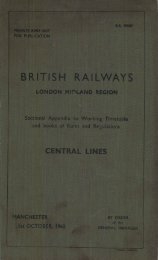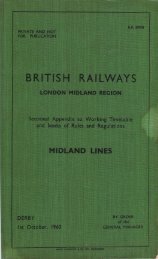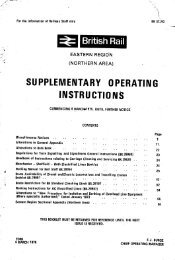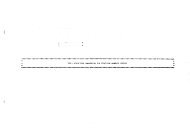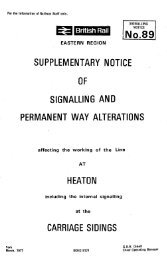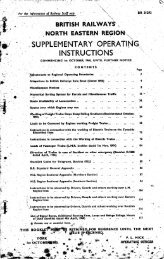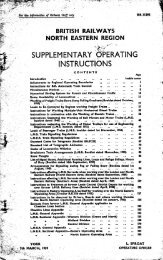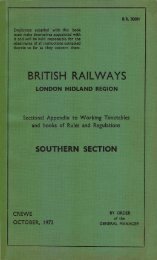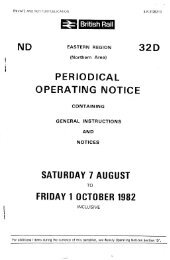general instructions. - Limit Of Shunt
general instructions. - Limit Of Shunt
general instructions. - Limit Of Shunt
Create successful ePaper yourself
Turn your PDF publications into a flip-book with our unique Google optimized e-Paper software.
General Instructions.—Continued. 1 4 9<br />
Working of Four and Six-wheeled Vehicles on G.C. Passenger Trains.<br />
General Rule 165.<br />
Six-wheeled vehicles (other than six-wheeled first class saloons) and fourwheeled<br />
Passenger Coaches must not be run on any of the express trains<br />
in the London and Manchester or Bradford through services.<br />
The six-wheeled first class saloons must not be run in these services unless<br />
the sanction of their District Traffic Manager or District Superintendent<br />
has first been obtained.<br />
Six-wheeled passenger coaches and four-wheeled horse boxes and carriage<br />
trucks may be attached to the G.C. Co.'s trains working to and from this<br />
Company's system, but such vehicles must be marshalled together, either<br />
in front or rear, and not intermixed with bogie stock ; this must also<br />
apply to N.E. trains working between Hull and Sheffield G.C.<br />
Attaching of Four and Six-wheeled Vehicles to GM. Empty<br />
Coaching Stock Trains.<br />
General Rule 165.<br />
When bogie stock is run on Empty G.N. Coaching stock trains it must<br />
be in front of vehicles with six or four wheels respectively.<br />
PASSENGER COMPARTMENTS NEXT ENGINE.<br />
General Rule 165.<br />
When a passenger carriage is the next vehicle to the engine on express<br />
trains, the compartment nearest the engine must as far as practicable be<br />
locked, and passengers prevented from travelling in it. This rule does not<br />
apply if there is a luggage compartment between the passenger compartment<br />
and the engine, nor does it apply in the case of corridor stock where there<br />
is a lavatory or a passage between the end of the vehicle and the leading<br />
compartment.<br />
It is not necessary' to prevent passengers travelling in the compartment<br />
nearest the engine in the case of ordinary passenger trains, or trains made<br />
up of an engine and one vehicle only, or an autocar train. ( 0 . 1901).<br />
PASSENGER COMPARTMENTS NEXT ENGINE ON TRAINS<br />
FROM N.E. TO G.N. LINE.<br />
General Rule 165.<br />
Trains working to the G.N. line may have ordinary passenger vehicles<br />
attached next the engine provided the two front compartments are locked<br />
up. In the event of a saloon or corridor vehicle being attached to the front<br />
of the train a van must in every case be attached between such vehicle and<br />
the engine.<br />
When stations north of York attach a vehicle for the G.N. line so that<br />
it will be between the front van and the engine, on leaving York, that<br />
station must, in wiring York, give a description of the vehicle so that the<br />
staff may know whether to be prepared with a van.<br />
EMMY VEHICLE IN FRONT OF L. & N.W. PASSENGER TRAINS WHERE<br />
OCCUPIED VEHICLES ARE NEXT THE ENGINE.<br />
General Rule 165.<br />
Where saloons are attached next the engine of trains from this Company's<br />
line to the L. & N.W. line, and no dummy vehicle is provided, a wire must<br />
be despatched to the Stationmaster at Leeds informing him of this in order<br />
that arrangements can be made for a dummy vehicle to be attached between<br />
the engine and the saloon at Leeds. ( O . 5812).




